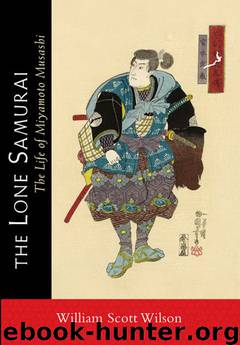The Lone Samurai by William Scott Wilson

Author:William Scott Wilson
Language: eng
Format: epub
Publisher: Shambhala Publications
THE CONCEPT OF THE FIVE RINGS IN ESOTERIC BUDDHISM
Traveling the backroads of Japan or wandering through the temple precincts there, one often finds five-tiered stone monuments called stupas. These can range from two to more than ten feet high and they are often made of plain granite or some other hard stone. Stupas are descended from original monuments that held relics of the Buddha and, later, his saints. Believers consider them to hold the actual presence of the Buddha or his Truth. There is an interesting connection between this ubiquitous monument and The Book of Five Rings that is worthy of note.
When the monk Kukai returned to Japan from China in C.E. 806, he brought with him an understanding of a new, esoteric form of Buddhism that he called the Shingon, or True Word, sect. Kukai was not only a devout Buddhist but a brilliant teacher, and an artist. He is credited with having created the kana system of Japanese orthography (the syllabaries that are used together with kanji), and is considered the patron saint of calligraphy. The Shingon sect grew rapidly in importance during his lifetime and gained favor especially among the aristocracy, who loved its rituals and artistic representations. Kukai taught that the esoteric meanings of Shingon could be conveyed not in wordy explanations, but rather through art. This notion of Truth through Art had a direct appeal to Japanese sensibilities, and the basic assumptions of Shingon have always been a strong undercurrent in Japanese culture, despite the later ascendancy of the Zen and Pure Land sects of Buddhism. Even the tea ceremony, with its well-known connections to Zen, probably in fact owes its aesthetic foundations more to Shingon than to Zen.
Among the tenets of Shingon Buddhism is the assertion that the esoteric teachings were taught not by the historical Buddha, Shakyamuni, but by Vairocana, the cosmic Buddha, who is in fact the universe itself. Vairocana is manifested in a number of artistic forms, but in Japan he is often represented by the five-tiered stone pagoda, or sotoba, also called the gorinto, or Tower of Five Rings (Gorin no sho is the Japanese title of Musashi’s book; sho means “book). This gorinto is usually constructed as follows: a square stone at the bottom represents the Earth Element, or stability and the fundamental element of being; next, a round stone represents the Water Element, or permeation and vacuity; a triangular stone represents the Fire Element, or purity and perfect activity; a crescent-shaped stone represents the Wind Element, or growth and perfect awareness; and, at the top, a stone in the shape of a mani-jewel (wish-fulfilling gem) represents the Void Element, or space. The stones are inscribed respectively with the Sanskrit letters A, Vi, Ra, Hum, and Kham, which together represent Vairocana himself, the very essence of the universe.
According to Kukai, these five elements are constantly interfusing to form the various manifestations of the universe, and hence Vairocana. We see the forms, but we are too unenlightened to recognize them for what they are.
Download
This site does not store any files on its server. We only index and link to content provided by other sites. Please contact the content providers to delete copyright contents if any and email us, we'll remove relevant links or contents immediately.
The remains of the day by Kazuo Ishiguro(8817)
Tools of Titans by Timothy Ferriss(8213)
Giovanni's Room by James Baldwin(7188)
The Black Swan by Nassim Nicholas Taleb(7009)
Inner Engineering: A Yogi's Guide to Joy by Sadhguru(6722)
The Way of Zen by Alan W. Watts(6504)
Asking the Right Questions: A Guide to Critical Thinking by M. Neil Browne & Stuart M. Keeley(5631)
The Power of Now: A Guide to Spiritual Enlightenment by Eckhart Tolle(5603)
The Six Wives Of Henry VIII (WOMEN IN HISTORY) by Fraser Antonia(5394)
Astrophysics for People in a Hurry by Neil DeGrasse Tyson(5130)
Housekeeping by Marilynne Robinson(4329)
12 Rules for Life by Jordan B. Peterson(4249)
Double Down (Diary of a Wimpy Kid Book 11) by Jeff Kinney(4204)
The Ethical Slut by Janet W. Hardy(4172)
Skin in the Game by Nassim Nicholas Taleb(4161)
Ikigai by Héctor García & Francesc Miralles(4123)
The Art of Happiness by The Dalai Lama(4063)
Skin in the Game: Hidden Asymmetries in Daily Life by Nassim Nicholas Taleb(3929)
Walking by Henry David Thoreau(3892)
